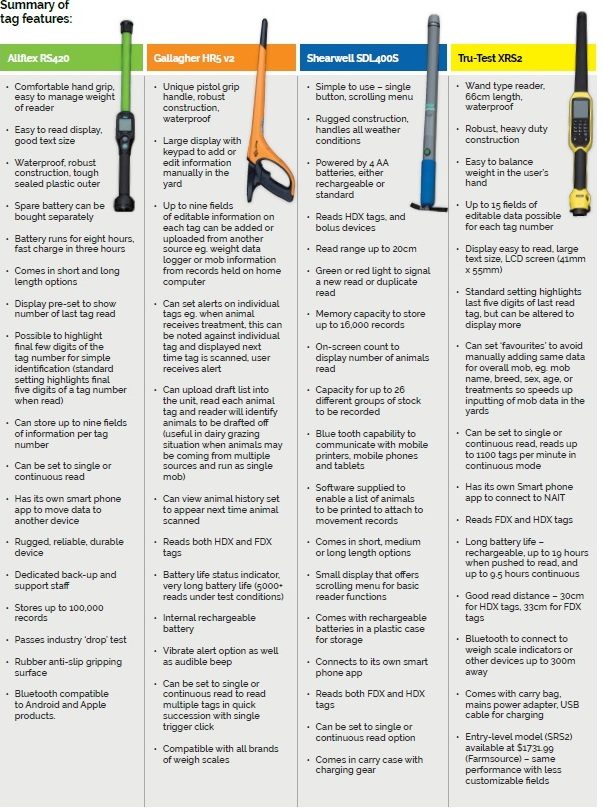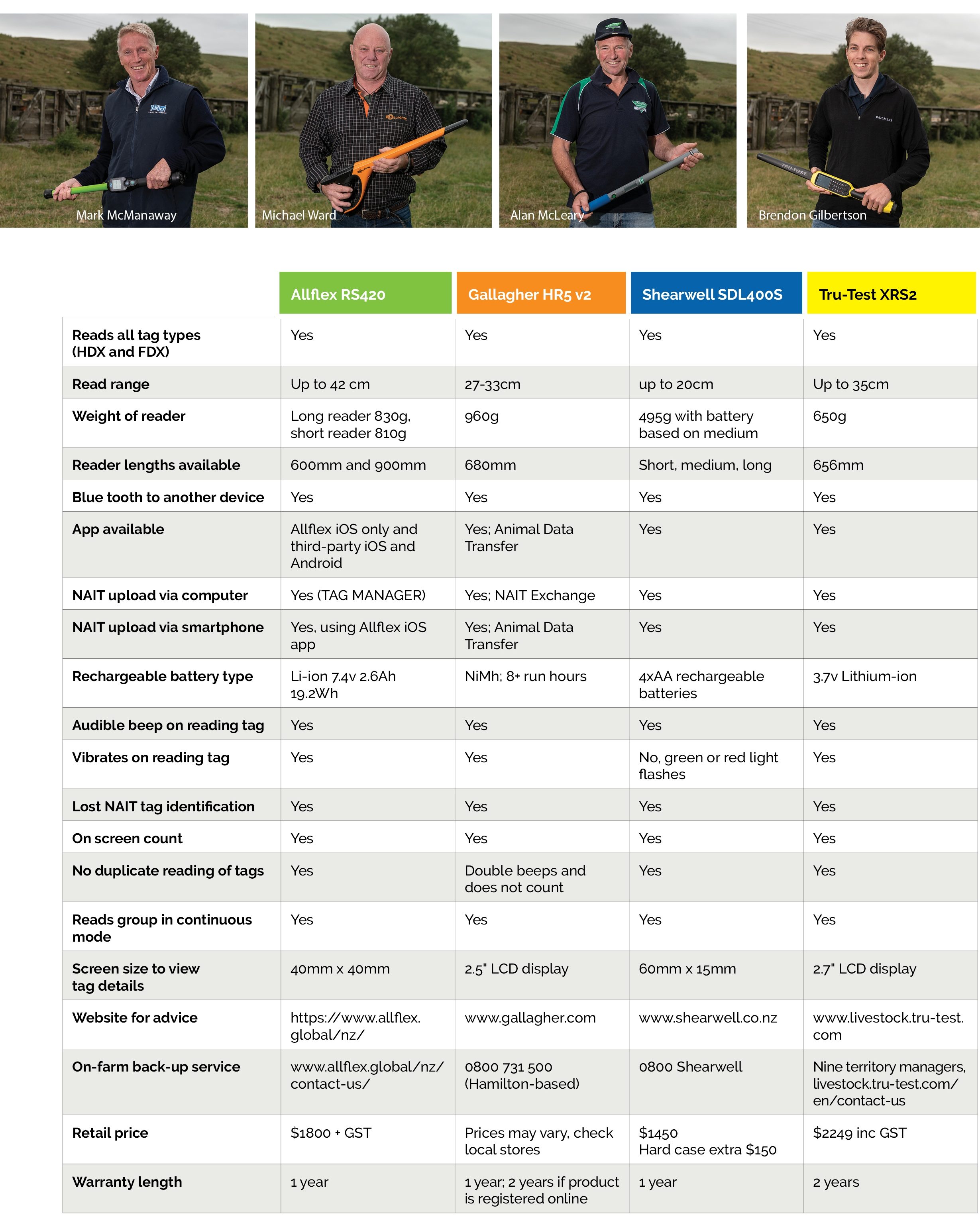On behalf of farmers and industry stakeholders, Ospri/NAIT commissioned Country-Wide to put all readily available electronic tag readers through their paces earlier this year in a special ‘test drive’ to see how they perform. Tony Leggett investigates.
Our test drive began with an invitation to five companies to provide an off-the-shelf ‘stick’ reader suitable for a farmer with limited previous experience to read electronic ear tags in a mob of cattle.
Although our test farm runs a beef cow herd of 160 mixed-age cows, breeding its own replacements and selling sale progeny either at weaning or yearling age, it must comply with similar tagging and identification requirements to dairy and dairy grazing farms.
All five companies agreed to participate but Leader Products NZ withdrew soon after because it is still trialing a new range of readers and software for release in New Zealand in 2020.
The four companies with readers in the test were Allflex, Gallagher, Shearwell and Tru-Test (acquired by Datamars in 2019).
The tag reader models were:
- Allflex RS420
- Gallagher HR5v2
- Shearwell SDL400S
- Tru-Test XRS2
For the test, a small mob of yearling cattle were put in the race which had a walkway on the left-hand side. The cattle were tagged in their right ears, so reading the tags meant the reader had to be positioned near the right ear of each animal on the far side of the race from the walkway.
The readers all have a screen with push-button menu to scroll through fields to view the collected data. Screen size varied. The Shearwell unit had the smallest screen but adequate text size. The others had larger screen sizes, and all were easy to read and review data on.
All the readers have the capacity to send data to another device through Bluetooth, or store information on individual animals, and set alerts that provide an audible sound when that tag is read in the future.
This is helpful when, for example, stock receive an animal remedy that has a withholding period before the animal can be slaughtered, or when something unique about the animal could be required in the future like an injury.
Two of the readers, the Tru-Test and Gallagher units, also have the capability to upload weight data on individual animals to the reader from a weigh scale unit, via Bluetooth.
All four readers in our test passed the minimum requirement of being able to read each animal’s tag and make each number visible to the user in the yards. They were all able to collect a set of tag data from a mob and deliver it to another device (mobile phone or home computer or both) via Bluetooth, for uploading to NAIT.
Two of the readers in the test, from Gallagher and Tru-Test, had the capability to upload data direct to NAIT via a smartphone application, provided they have mobile coverage available.
In terms of using the readers, three were held like a drafting stick and one, the Gallagher unit, had a pistol grip.
All four units were encased in tough plastic outers, and all have claims of being suitable for use in wet weather. Our test did not include checking the waterproof claims, but the units all appeared robust, and worked perfectly despite the odd knock against rails or animals in the race.
All the units read a tag by depressing a button or trigger once the end of the reader is positioned over the tag in the animal’s ear. They all gave an audible signal to alert the user that each animal’s tag had been read. None of the readers allowed the user to read a tag more than once so there is no risk of duplication during scanning.
By changing the reader setting from individual tag to a continuous read mode, it is possible to read the tags in several animals with a single push of the reader button – for example a group of animals in a race. All the readers offer this feature.
A useful feature available on all four readers in the test is their capability to store visual tag numbers against which can be searched so the user can see the animal’s NAIT number. This is particularly useful when a NAIT tag has been lost and needs to be replaced (see table for ‘lost NAIT tag’ feature details).
Two of the readers, the Allflex and Shearwell options, offer longer length readers. This feature could be useful when reading tags from the pit in a dairy (see table for reader length details).
Advantage: Easier to own your own
Comment: Tony Leggett
All four stick tag readers in our test performed well at reading NAIT tags in the ears of a mob of cattle in the race, either individually or in a group when used in continuous-read mode.
They are robust and simple to operate, even for someone with limited experience.
All four readers can upload tag information to a device that connects to the NAIT website to record movements or perform other compliance activities, such as registering NAIT tags that have been inserted in a mob of calves for the first time.
What separates the readers is their capability to do extra actions and, to a small extent, their price.
The Allflex and Shearwell (or entry-level Gallagher and Tru-Test models) readers are ideal for a farm where small to medium numbers of cattle (or deer) movements take place in a typical year.
The Gallagher and Tru-Test readers in our test have greater capability to deal with more movement of mobs between properties or to slaughter, and can receive weight data on individual animals or mobs from a weigh scale unit via Bluetooth. These options would be very helpful for dairy and dairy grazing properties where mobs are mixed for easier management, and weights are being recorded to meet grazing contract conditions.
But they cost slightly more and for some farmers, like those operating a low-movement system, the extra capability may not be necessary. Both Gallagher and Tru-Test offer an entry-level reader similar to the Allflex and Shearwell options.
At a cost anywhere from $1450 to about $2250, the cost per year to own a tag reader is probably less than $200/year over a 10-year period.
What is clear is the need for every farmer who has deer or cattle on their property to comply with their NAIT requirements, recording movements and registering animals.
Owning your own reader is a no-brainer where you are moving stock on or off-farm on a regular basis. Having your own reader where you are only sending stock to sale yards or slaughter (where tags are read on arrival) might seem extravagant or unnecessary. But you only have to have one missing tag or one tag that isn’t registered to an animal that has arrived or been born on your farm, to realise how useful it would be to have scanned the animals in your own yard before they left the farm.
Another benefit of having your own reader available is being able to read the tags of any animals as they arrive on the farm in the yards so you can check the data against the movement recorded on the NAIT system. This overcomes the issues that occur when the same line of stock is moved off the farm in the future, and an animal is not recorded as arrived on your farm.
The decision to own, borrow or share a unit comes down to convenience and peace of mind.
Every dairy, beef or deer farmer should have access to their own tag reader. They should be viewed as an essential onfarm biosecurity tool, supporting disease management and traceability. They also take the effort out of compliance and they offer 100% accuracy.






